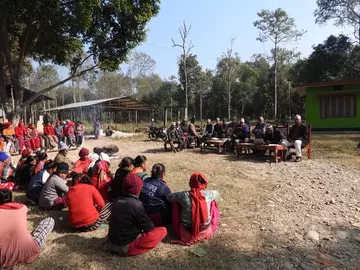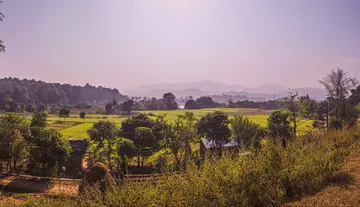
Future of tigers in Nepal
2022 saw the announcement of the doubling of Nepal’s wild tiger population over the last decade – our Deputy Country Manager in Nepal, Bhagawan Raj Dahal, explains how strong partnerships with local communities and governments will further the continued recovery of this iconic big cat.
Last year marked a major milestone for Nepal’s wild Bengal tiger (Panthera Tigris Tigris) population, with numbers doubling to 335 individuals within a decade. This amazing result would not have been possible without the tireless efforts of the government and local communities, working alongside national and international conservation agencies and other stakeholders. Such partnerships are essential for addressing the transdisciplinary nature of threats to tiger conservation. The population’s growth is a momentous achievement, but it comes with the challenge of supporting larger tiger numbers and mitigating increased risks of human-tiger conflict.

Collaborating with ITHCP
We're a part of the international Integrated Tiger Habitat Conservation Project (ITHCP), implemented in collaboration with the Governments of Nepal and India and their tiger conservation sectors, working to maintain tiger habitat, minimize human-tiger conflict and engage others in their protection across both countries. ZSL works in several Protected Areas (PA’s) in the Teri Arc Landscape (TAL) - a region spanning the Indian and Nepali border - including Parsa, Banke, Bardiya and Shuklaphanta National Parks in Nepal and Nandhaur Wildlife Sanctuary in India. Since ZSL began working in the landscape under the ITHCP in 2016, the area has experienced a 90% increase in tiger population size, alongside increases in tiger prey populations, including sambar deer. As the project moves into its third phase, strong transboundary partnerships are essential for maintaining wildlife populations and fostering better human-tiger coexistence. Resource limitations and natural behaviour mean tigers frequently move outside PAs into human-dominated landscapes, and due to the effects of climate change, tiger habitats will likely shift to higher altitudes outside of PA boundaries over time.

How to protect tigers in Nepal
To support tiger populations through these challenges, ZSL is implementing Phase III of the ITHCP with partners, stakeholders and community-based organisations, including the Department of National Parks and Wildlife Conservation, National Trust for Nature Conservation, Himalayan Nature, Uttarakhand Forest Department, Wildlife Institute of India and the National Tiger Conservation Authority. Phase III works closely with PA authorities from both countries, increasing the use of state-of-the-art conservation technology and running information sharing meetings to develop the habitat management and species monitoring skills and capacity of PA staff. Transboundary cooperation will be strengthened through exchange visits and stakeholder meetings, promoting collaboration and knowledge sharing between project sites.
Additionally, the project will work with local communities across TAL to raise awareness of conservation issues, promoting communities’ roles within it and facilitating human-tiger conflict mitigation efforts. A key and unique part of this work is the promotion of a relief fund for villages to support communities’ ability to cope with human-tiger conflict incidents. These activities call for close coordination between PA authorities and communities, thereby building strong park-people relationships. The project will also work closely with local people to develop income generating community-based enterprises, promoting tiger conservation further through delivering direct economic benefits from conservation efforts.

By working with a vast range of stakeholders, from national and international authorities to grassroots communities, the project will foster essential partnerships for tiger conservation. Endangered species such as tigers play a vital role in the Terai Arc Landscape ecosystem, and the project will build a strong foundation for further work to secure the future of Bengal tigers and wildlife living alongside them.
The Integrated Tiger Habitat Conservation Programme (ITHCP) is an initiative implemented by the International Union for Conservation of Nature (IUCN) and funded by German Cooperation via KfW Development Bank, which contributes to the global effort to double tiger numbers in the wild by 2022 by supporting landscape level conservation work benefiting species, communities and habitats. Coordinated actions enhancing conservation skills, developing new livelihoods and improving governance and infrastructure are delivering results in terms of better protected tigers across these landscapes. This project is supported by IUCN’s Integrated Tiger Habitat Conservation Programme, funded by the German Cooperation via KfW Development Bank. The contents of this are the sole responsibility of the ZSL and do not necessarily reflect the views of IUCN, the German Cooperation or KfW.
